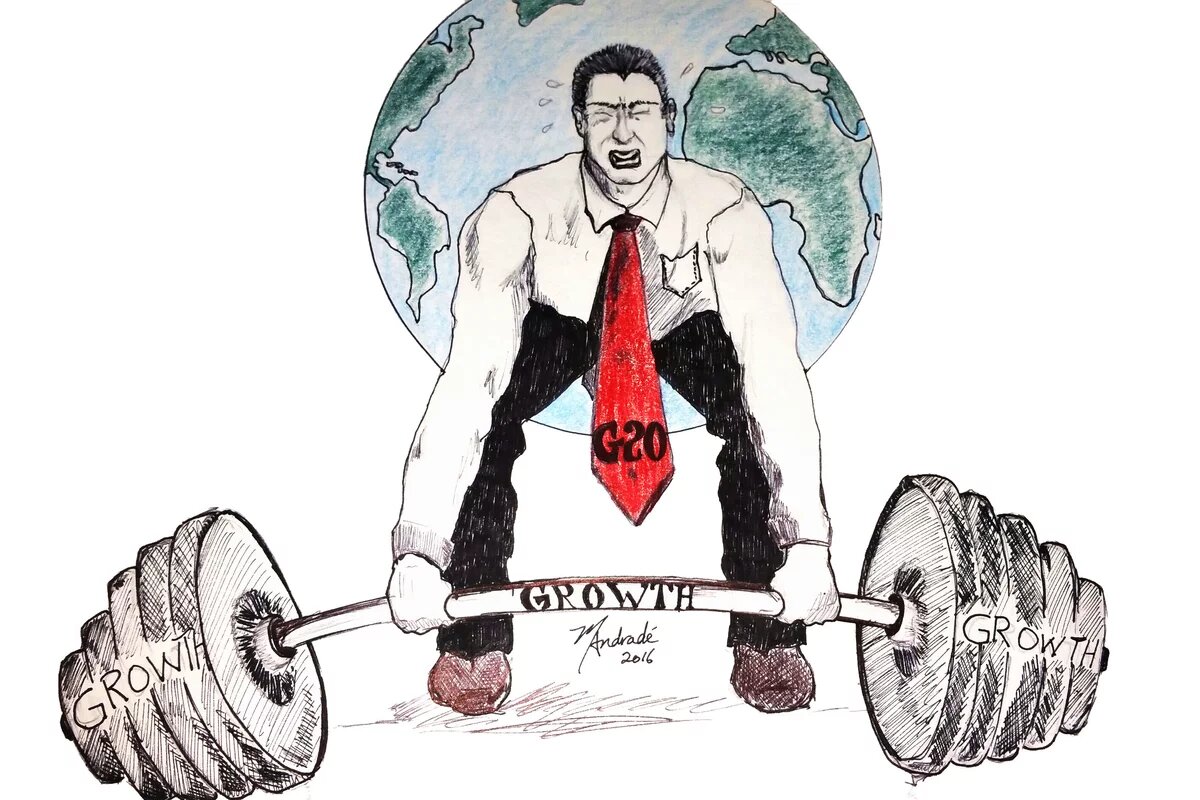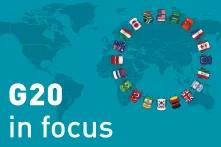

Apart from the G20’s apparent lack of effective strategy and implementation of its own pledges, its growth vision lacks full coherence with sustainable development. Instead of wishfully hoping to retrace an economic growth trajectory of the past, the G20 should advance coherent sustainable development.
1. What are the stated G20 goals and commitments in relation to this topic?
Promoting global economic growth is the raison d’etre of the G20. In 2009, in the throes of the global financial crisis, the G20 launched the Framework on Strong, Sustainable and Balanced Growth (the “Framework”) at the G20 Summit in Pittsburgh, U.S. (The word “sustainable” in the Framework refers to sustainable economic growth with the notion of sustaining stable, non-inflationary and balanced growth, and not of environmental or social sustainability.) While the G20 lacks a charter, the Framework is the closest thing to it - in fact, it is the G20’s “holy grail.” Ever since then, each G20 country has been required to prepare its National Growth Strategy for each successive Summit. The Australian, Turkish, and Chinese G20 Summits made important growth related commitments. Here is what each Summit announced:
AUSTRALIA (2014): Signaling its commitment to growth, the Communiqué of the 2014 G20 Leaders’ Summit announced the “two in five” (two percent in five years) G20 growth target:
This year we set an ambitious goal to lift the G20’s GDP by at least an additional two per cent by 2018. . . This will add more than US$2 trillion to the global economy and create millions of jobs. Our measures to lift investment, increase trade and competition, and boost employment, along with our macroeconomic policies, will support development and inclusive growth, and help to reduce inequality and poverty. (Para. 3)
Driven by a strong sense of purpose to deliver the growth target, the G20 countries committed to some 1,000 structural reform measures to achieve the goal set in Australia.
TURKEY (2015): In the following year, the November 2015 Turkish Summit took place between two critical UN-related events. The Summit was just over a month after the UN Special Summit on Sustainable Development, which launched the UN 2030 Agenda on Sustainable Development (the “2030 Agenda”) and the 17 Sustainable Development Goals (the SDGs). The 2030 Agenda highlighted an important aspect of sustainable development, which is inclusivity. It was also mere weeks before the Paris Conference on Climate Change where countries made commitments to cut greenhouse gas emissions.
Consistent with the 2030 Agenda, the Turkish Summit elaborated on the meaning of “inclusive growth” within its three central themes of implementation, investments and inclusiveness. The Turkish Leaders’ Communiqué connected the dots between global growth, social well-being, and inequality. Among other things, the Turkish G20 seemed to signal that the core growth mission of the G20 would include emphases on decent work; women and youth; small and medium sized enterprises (SMEs); and less developed countries. The G20 Leaders explained that more needed to be done because “[g]lobal economic growth is uneven and continues to fall short of our expectations,” and that “[r]ising inequalities in many countries may pose risks to social cohesion and the wellbeing of our citizens and can also have negative economic impact and hinder our objective to lift growth.” (Para.6) Furthermore, the G20 Leaders also promised to set up an action plan to align G20’s work with the SDGs.
CHINA (2016): Notwithstanding the Leaders’ pledge to work harder to lift growth, disappointing economic data continued to roll in in 2016 and threatened to overshadow the Chinese Presidency of the G20. Global growth continued to weaken. According to the IMF’s forecasts, the G20s’ GDP would be three per cent smaller in 2018 instead of being two per cent larger, as promised in Australia. Both trade and investment, the two pillars of the G20 growth strategy, had performed below projections. (See G20 Trade and Investment Fundamentals.) Many fretted about the “low growth trap” becoming the new normal.
Concerned with poor economic performance and rising discontent with globalization, the G20 Leaders at the Chinese Summit put forward yet another vision for growth: “innovative, invigorated, interconnected and inclusive world economy to usher in a new era of global growth and sustainable development.” (Para. 5)
This Communiqué also pledges coherent national actions, stating: “We commit to contributing to the implementation of the 2030 Agenda by setting an example through bold, transformative collective and intended national actions in a wide range of areas.” (Para. 33)
In summary, G20’s growth pledge as it stands today is laced with important qualifiers that accumulated over the years – namely, that growth should be strong, economically sustainable, balanced, inclusive, aligned with the 2030 Agenda, innovative, and labor-intensive. However, its follow-up on the pledges is uneven. Failure to implement national commitments could be responsible for some shortfall in global growth ambitions. Moreover, the G20 lacks collective action on most issues other than structural reforms. (The topic of climate change had been taboo among the G20 until the China-led Summit when Leaders endorsed the Paris Climate Change Agreement.)
If the G20 was serious about its pledges, the G20’s discourse on sustainable development could be a credible starting point for the G20 to reverse inequality, fully embrace the SDGs, and meet the demands of citizens around the world. However, the past G20 actions indicate that this discourse takes place apart from the growth discourse, and the two paths do not readily intersect at the G20.
2. Why is this topic important?
We begin this section by discussing the meaning of growth and the cycle of growth. This is followed by an observation on neoliberalism and its negative effects, such as inequality.
The meaning of growth and the cycle of growth: In economists’ language, “growth” means economic growth, measured by way of gross domestic product or GDP, which is a broad measure of goods and services produced across the economy. GDP is indifferent to the nature of the production or output, whether food or cigarettes, smart phones or guns. GDP is the single most prevalent indicator of economic “progress,” a supposed measure of economic health and well-being, used by policy makers, countries and international organizations, the G20 included. We mistakenly equate it with societal progress and collective well-being.
Growth has distinct cycles, and governments and economic actors respond to these cycles in various ways. During boom years, the rising tide of growth does lift many boats – higher incomes can move people out of poverty, lower unemployment, and reduce inequality. Higher taxes can reduce government spending and promote better services. And, growth encourages investment, which encourages more growth. Higher income has the potential to reduce inequality, but may not if it is not broadly distributed. Inequality can actually increase during a period of growth.
With rapid growth comes a multitude of other problems. These include environmental costs, such as depletion of natural resources, waste products that pollute the atmosphere, water, and soil; and, biodiversity loss; and climate change. Experts claim that human activity has far exceeded the carrying capacity of the earth (planetary boundary) and could present the risks of irreversible and abrupt environmental change.[1]
During a downturn of an economic cycle, we see very low or negative economic growth, rising unemployment, lower asset prices and investment, higher government spending and lower tax revenue, leading to fewer services and increased government borrowing, among other things. Countries that find themselves in this situation often resort to austerity measures. Take the 2008 financial crisis, for example. The under-regulated and over-extended financial sector had to be bailed out, increasing public sector debt. The financial crisis triggered a deep recession to which some governments responded by deficit spending. Others adopted austerity measures to control public debt and to stem budget deficits. Austerity contracts government spending, and inevitably fosters inequality and unemployment, while creating a drag on long-term growth. The sequence of events in the recent Greek financial crisis and bailout illustrates the profound effect of austerity on its economy, social contract, and national well-being.
Neoliberalism and Inequality: The theory of laissez-faire (French for “leave alone”) liberalism has been popular since the 18th century. It assumed that, as governments ceased interference, economies and societies would prosper. Then, in the 1980s, Reagan in the U.S. and Thatcher in the U.K. began to systematically apply a theory called “neoliberalism,” which embraces free markets, privatization, deregulation, and public spending cuts. It promotes competition in economic activity in an effort to foster economic growth. The theory also calls for the private sector (which is presumed to be efficient and competitive) to push aside the state in order to deliver goods and services, including public services (e.g., water supply, health care, education) for a profit.
Neoliberalism also involves liberalizing trade and investment policies so that the state does not “crowd out” private investors. Under this theory, citizens must spend and consume in order to keep growth strong. Many attribute globalized trade and investment and the accompanying rewards we see today, such as technology transfer and poverty reduction, to neoliberalism.
Critics of neoliberalism contend that neoliberalism, taken to an extreme, has contributed to calamitous developments, such as inequalities so profound that they fuel populist revolts. From 1990 to 2014, GDP increased three times over[2]; foreign direct investment ten times over (2013)[3]; and trade five times over[4], yet inequality in income and wealth has skyrocketed within countries and between countries.[5]
In the U.S., income inequality took off in the 1970’s and has surpassed prior highs. Wages of the middle-class have stagnated for some 40 years. Now, many anxious years after the 2008 global financial crisis, job creation is finally up and unemployment is down in the U.S., yet wages are not rising. Why is this?
Many factors relating to neoliberalism, as described above, are accompanied by increasing concentration of financial power. When commercial actors have the power to control elected officials and regulators, we say that they have “captured” the government, which handicaps governmental attempt to protect or benefit citizens. Some evidence shows that a reason that wages have stagnated in the U.S. is that shareholders (backed by investors like hedge funds) rather than workers reap the lion’s share of the rewards of production.[6] Of course, there are many other reasons that wages have stagnated, not the least of which is technology and automation, but it is important that certain corporate revenues and profits traditionally set aside for research and development, expansion of production, and worker wages are now paid out to shareholders and investors. This is just one example of how financial power is exercised to the detriment of the middle class.
IMF researchers warn that key parts of neoliberal economic policy have increased inequality and can stunt economic growth across the globe. Looking at just two aspects of neoliberalism[7], the researchers claim that these policies engender inequality and might “undercut growth, the very thing that the neoliberal agenda is intent on boosting. . . Increased inequality in turn hurts the level and sustainability of growth. Even if growth is the sole or main purpose of the neoliberal agenda, advocates of that agenda still need to pay attention to the distributional effects.”[8]
There is another dimension to inequality. Although consumption of goods and services has risen steadily in industrial nations for decades, and is growing rapidly in many developing countries, great disparities remain. The twelve percent of the world’s population that lives in North America and Western Europe accounts for 60 percent of private consumption spending, while the one-third living in South Asia and sub-Saharan Africa accounts for only 3.2 percent.[9] Thus, inequality in consumption means that those in the developed world should shoulder considerably more responsibility for our planet crossing the planetary threshold for a healthy and stable environment. Such inequality, along with inequality in income and wealth, undercuts the very growth that the G20 pursues. The G20 growth strategy seems to assume infinite natural resources and clean air, which as we know, is absurd.
For the last few years, inequality appeared repeatedly as one of the top issues that worried world leaders gathered at the World Economic Forum (WEF) in Davos, Switzerland. As early as in 2015, the Economist summarized the sentiment of world leaders: “In all sections of society, there is growing agreement that the world is becoming more unequal, and that today’s disparities and their likely trajectory are dangerous.”[10] The WEF’s Global Risks Report 2017, “in line with the fact that rising income and wealth disparity is rated by GRPS (Global Risk Perception Survey) respondents as the most important trend in determining global developments over the next 10 years” suggest that “reforming market capitalism must also be added to the agenda.”[11] These observations capture the state of the chaotic world today, and exemplified by the recent world events, including Brexit and the outcome of the 2016 U.S. Presidential election.
3. What are the developments so far and the challenges in relation to this topic?
To date, G20´s success lies in the recognition (however imperfect) that growth must be inclusive and there must be coherence between economic policies, on the one hand, and sustainable development, on the other. The 2016 Leaders’ Communiqué stated:
“Our growth, to be strong, sustainable and balanced, must also be inclusive. We are committed to ensuring the benefits of our growth reach all people and maximize the growth potential of developing and low-income countries. In this context, we place sustainable development high on the G20 agenda.” (Para. 32)
Unfortunately, the G20’s policies and actions diverge significantly from this lofty statement. Not only did the G20 fail to embrace more inclusive policies but it also moved the respective economies further away from achieving sustainable development (for example in relation to climate change targets). In fact, the G20 actually managed to miss its economic growth targets. Only a few months after the Chinese Summit, the G20 growth strategies already look out of touch, in the face of poor economic performance and the rising anti-globalization populist movements around the world. The G20’s growth model which liberalizes trade and investment policies in order to drive growth has stalled, in part due to G20’s own short-sighted protectionist measures. Now the G20 growth targets could be out of reach for years.
In response, the G20’s “magic bullet” to restore growth involves implementing more neoliberal structural reform measures. In 2014, G20 governments committed to a thousand structural reform measures, only half of which has been fulfilled (and of those fulfilled, many reforms were what countries were already implementing or planning to implement).[12] Notwithstanding the great fanfare with which the G20 announces their annual communiqués and action plans, the G20 Leaders appear to be clueless to stem the poor economic performance other than to borrow again and again from their well-thumbed neoliberal text book; worse, it does not even deliver on their grandiose commitments. At the same time, the G20 is counting on being able to contain populist protectionist sentiments by effective “communication” of the virtues of globalization and increased investment and trade. The G20 does not seem to realize that better public relations while maintaining “business as usual” can no longer deliver results.
Apart from the G20’s apparent lack of effective strategy and implementation of its own pledges, its growth vision lacks full coherence with sustainable development. The G20 did deliver on its commitment to produce an Action Plan on the SDGs, though its coverage of the goals appears oddly patchy and needs to be fully thought out in consultation with the United Nations. Most strikingly, the Action Plan avoids addressing how growth can respect planetary boundaries, which means among other things, ensuring that global warming does not exceed 1.5 degrees Celsius.
In terms of implementation, the Action Plan is meant to advance the 2030 Agenda collectively through the G20 Development Working Group as well as through each G20 country’s own policies and actions. With regard to its collective action, the G20 suggests that each of its work areas (called “sustainable development sectors”) will advance specific SDGs, without identifying how this might occur. In examining the details of the G20’s domestic pledges, it is evident that each G20 country sets and executes its own goal with little consistency across the board. For example, some countries exclude any actions related to the natural environment.
4. What is the desired future direction of the G20 with respect to growth?
It is indeed time to replace our outdated neoliberal and growth-oriented economic system with a new economic and political system fit for the 21st Century. To do so, political movements are organizing around the world.
Meanwhile, here are some thoughts and questions for the G20, and the stakeholders and scholars of the process to consider and debate.
Measurement of Growth: What kinds of indicators should be measured in addition to, or in lieu of, GDP in order to ensure our collective progress and well-being?
Parliamentarians and government officials in Europe have been discussing for some time the pitfalls of GDP accounting, including France (Stiglitz-Sen-Fitoussi commission), the UK (leading to the report Prosperity without growth by Tim Jackson), and Germany (the Enquete-commission of the Bundestag). Research in multiple disciplines has shown that the focus on GDP is “mismeasuring our lives.” It has raised cogent doubts about the positive relationship (beyond a certain threshold) between further GDP growth and employment, welfare, distribution, equality, and happiness, respectively. Numerous studies have raised the possibility of decoupling further economic growth from resource consumption and emissions.
GDP would look very different if GDP counted unpaid work (usually done by women), says the World Economic Forum economist, Diane Coyle.[13] The Turkish G20 suggested the integration of women into economic activities, which could trigger different measurements of progress if, in fact, women were integrated into “decent work” including equal pay rather than assembly lines in free trade zones that are exempt from labor protections. Many other credible models offer alternatives to our GDP-centric economic model.[14]
The Sustainable Development Goals/Climate Change: What kind of growth strategy should the G20 devise to enable each of the G20 countries to meet the SDGs and its commitments under the Paris Climate Change Agreement? For starters, each G20 country should revise its growth strategy in order to show how it will achieve its emissions reductions to address climate change and the SDGs. In addition, investment and infrastructure guidance should be revised for the same purpose.
Policies to reverse Inequality: Experts agree that inequality is a result of public policy (including neoliberalism) and hence is reversible by public policy. G20 Leaders should understand that inequality eats into the growth that they want to promote. In addition, it must work with its ministers of finance and central bank governors to examine monetary and fiscal policies that can create redistributive effects. For instance, it should adopt progressive rather than regressive policies in each sector, such as a progressive tax policy, which puts greater burdens on the rich than the poor to support the common good.
“Degrowth” Strategy: Looking beyond these measures, should the G20 Leaders reconsider the growth strategy in light of globalization, growth, consumption, and the planetary consequences, and if so, what does an alternative growth strategy look like? Is there a need for countries to recognize the necessity for “common but differentiated responsibility” for the stark disparity in consumption between the North and South, and if so, what does the responsibility look like?The possibilities of achieving further quantitative growth have become more and more precarious due to resource and energy scarcities. These trends led to declining or stagnating growth rates in the early-industrialized countries. Average per capita growth rates in Western Europe have, for example continuously decreased from 5 percent annually in the 1950s to around 1 percent in the 2000s.[15] A growing number of economists are convinced that it will be impossible to repeat the phenomenal growth rates of the last century. Growth will most likely be much slower in the 21st century or even stall. Moreover, research shows that achieving equitable boundaries will only be possible if the countries in the North drastically reduce their ecological footprint, which most likely implies reductions of economic output. These and other related pressing questions about the future of growth in the 21st century are conspicuously absent from the G20 discourse to date.
The “degrowth”[16] alternative, which has been discussed in Europe for the last few years, argues that rich countries must reduce their consumption of raw materials, resources and land, as well as their emissions and waste products, to a level that is sustainable in the long run and that allows the countries in the South to have equal access to development opportunities. This school of thought shows that there are viable alternatives for societies to achieve a good life for all beyond economic growth.
Instead of wishfully hoping to retrace an economic growth trajectory of the past, the G20 Leaders should come together to advance coherent sustainable development, and rethink the benefits and pitfalls of growth-oriented policies in an era of secular stagnation, rising inequality, and climate change. In the process, they should be open to a different growth trajectory that ensures our common survival, with each G20 country accepting its share of responsibility in protecting our common planetary boundaries.
This article is part of our dossier "G20 in Focus".
Annotations:
[1] Stockholm Resilience Centre. The nine planetary boundaries.
[2] The World Bank. GDP (current US$).
[3] The World Bank. Foreign direct investment, net inflows (BoP, current US$).
[5] Oxfam (2016) An Economy for the 1%.
[6] Meyerson, Harold (2015) Why salaries don’t rise. The Washington Post, March 12, 2015.
[7] “[R]emoving restrictions on the movement of capital across a country’s borders (so-called capital account liberalization); and fiscal consolidation, sometimes called “austerity,” which is shorthand for policies to reduce fiscal deficits and debt levels.” Infra 5.
[8] Ostry, Jonathan D., Lougani, Prakash, Furceri Davide (2016) Neoliberalism Oversold?.
[9] Worldwatch Institute (2017) The State of Consumption Today.
[10] The Economist (2012,) For Richer, for Poorer. October 12, p. 6.
[11] P.6.
[12] Triggs, Adam (2016). Is Asia Doing the Heavy Lifting in the G20?
[13] Coyle, Diane (2016). The way we measure economies is inherently sexist.
[14] For example, see: https://www.weforum.org/agenda/2016/04/beyond-gdp-is-it-time-to-rethink-the-way-we-measure-growth; also: https://www.weforum.org/agenda/2016/04/five-measures-of-growth-that-are-better-than-gdp/
[15] Bergeaud, Antonin, Cette, Gilbert and Lecat, Rémy (2015). GDP per capita in advanced countries over the 20th century.
[16] Giacomo D’Alisa, Federico Demaria, and Giorgos Kallis, eds., Degrowth: A Vocabulary for a New Era (London and New York: Routledge, 2014); Tim Jackson, Prosperity without Growth: Economics for a Finite Planet (London: Earthscan, 2009); Matthias Schmelzer, The Hegemony of Growth. The OECD and the Making of the Economic Growth Paradigm (Cambridge: Cambridge University Press, 2016).



